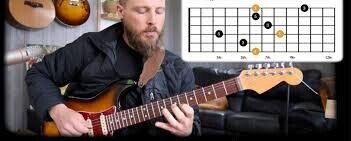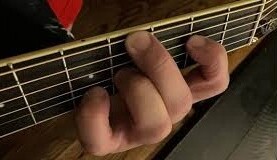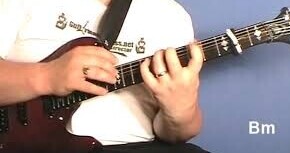 Getting the basics right is key to mastering arpeggios on the electric guitar. Arpeggios are a staple in music theory, basically broken chords where you play each note individually. They sound great and help you navigate the fretboard with ease.
Getting the basics right is key to mastering arpeggios on the electric guitar. Arpeggios are a staple in music theory, basically broken chords where you play each note individually. They sound great and help you navigate the fretboard with ease.
For electric guitar players, arpeggios are like secret weapons that can supercharge solos and riffs. They bring a new dimension to your playing, making everything sound more fluid and connected. If you want to stand out, getting comfy with arpeggios is a must.
Starting with the essential arpeggio shapes and patterns is smart. There are simple shapes like minor and major arpeggios that every guitarist should have in their toolkit. Practicing these basic shapes until they become second nature is crucial for moving on to more advanced stuff.
Finger movement and hand positioning are really important when you’re getting into these arpeggios. Proper hand positioning can prevent injuries and make transitions smoother. It’s all about finding what feels natural while maintaining good technique.

Before diving into the advanced techniques, having a solid warm-up routine is essential. Warm-ups help flex those muscles, getting them ready for the complex movements that arpeggios demand. A good warm-up can also help in keeping your playing clean and crisp, making practice sessions more productive.
Incorporating Advanced Techniques: Elevating Your Sound
Once you’ve nailed the basics, it’s time to inject some serious flair into your arpeggios. Advanced techniques can turn your solos from mundane to mesmerizing, and there’s nothing quite like hearing a sweet sweep picking run to really make ears perk up.
Sweep picking is a technique that helps play arpeggios faster and smoother. Unlike usual picking, sweep picking lets you play several notes in one fluid motion, almost like a brushstroke. It’s a bit tricky at first, but with practice, you’ll glide across strings with finesse. It’s pure magic when done right.

Tapping adds an extra splash of excitement to arpeggios. By incorporating tapping, you can hit notes that are further up the neck, creating complex and impressive sounds. It’s a favorite among guitar greats for a reason—it gives arpeggios a new dimension that just strumming can’t achieve.
Speed and fluidity are crucial, but they come with practice and patience. String skipping can give arpeggios a unique sound and requires nimble fingers. This technique throws traditional playing out the window and pushes boundaries, letting you craft arpeggios that dance across strings in unexpected ways.
Spice things up by incorporating exotic scales like the Dorian or Phrygian. Mixing scales with arpeggios can make your playing more colorful and interesting. This is where you start becoming more than just a player—you become an artist, painting with sound.
Remember, precision beats speed. It’s tempting to play as fast as possible, but speed without control can sound messy. Focus on getting each note right, then gradually speed up. The better your control, the more impressive your arpeggios will sound, even at lightning speed.
Creative Expression: Personalizing Your Arpeggio Style

This is where arpeggios truly become your own. Adding personal flair and style is all about experimenting with different variations in dynamics and rhythm. Changing up how hard or soft you strike the strings can create varying moods in your playing, letting emotions shine through each note.
Using arpeggios in your solos adds depth and emotion to your music. This involves more than just technical skill; it’s about telling a story through your guitar. Find the feeling you want to convey—be it joy, sorrow, or anger—and let your hands speak for your heart.
Arpeggios can transform when you introduce them to different musical genres. Rock, blues, jazz, or even classical music—they all provide unique platforms for arpeggios to stand out. Each genre brings its own challenges and creative opportunities, making them a playground for innovation.
Looking at your favorite guitarists can be a source of inspiration. Trying out their styles can help you learn new techniques, and from there, you can start blending what resonates with your sound into something uniquely yours.
Everyone hits creative blocks sometimes, but they can be opportunities in disguise. Try different scales or unusual time signatures to push your limits. Building a distinctive style takes time, but those who persevere often create the most memorable music.
Making It Your Own: Applying Arpeggios to Composition and Performance
Now comes the fun part: putting everything together in your music and performances. Arpeggios can transform your songwriting, creating depth and intrigue in compositions. They’re great for building musical narratives that keep listeners engaged and wanting more.
Transitioning smoothly between arpeggios and chord progressions can elevate any piece of music. By refining this skill, you can create seamless stories within songs, and give your audience something memorable to hold onto.
Structuring a solo around arpeggios can make it truly engaging. Solos benefit from a mix of technical prowess and emotional expression. When you master arpeggios, you’re all set to craft solos that captivate and entertain.
Today’s technology offers new opportunities to expand your sound palette with effects. From using delay to add dimension or distortion to create an edge, effects combined with arpeggios can innovatively redefine your sound. There are endless possibilities here to explore and play with.
Continuous improvement is key to mastering arpeggios. Every musician faces plateaus, but pushing past them by setting new goals, practicing regularly, and keeping the passion alive will ensure you’re always evolving as a guitarist.
